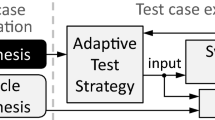
Overview
Access this book
Tax calculation will be finalised at checkout
Other ways to access
About this book
Similar content being viewed by others
Keywords
Table of contents (6 chapters)
Authors and Affiliations
Accessibility Information
PDF accessibility summary
Bibliographic Information
Book Title: Temporal Verification of Reactive Systems
Book Subtitle: Safety
Authors: Zohar Manna, Amir Pnueli
DOI: https://doi.org/10.1007/978-1-4612-4222-2
Publisher: Springer New York, NY
-
eBook Packages: Springer Book Archive
Copyright Information: Springer-Verlag New York, Inc. 1995
Hardcover ISBN: 978-0-387-94459-3Published: 04 August 1995
Softcover ISBN: 978-1-4612-8701-8Published: 22 August 2012
eBook ISBN: 978-1-4612-4222-2Published: 06 December 2012
Edition Number: 1
Number of Pages: XVIII, 512
Topics: Theory of Computation, Mathematical Logic and Formal Languages



